UNIT 1
Multidisciplinary nature of Environmental Studies:
A) Multidisciplinary nature of Environmental Studies:
Definition
Environment as a word covers the sum of extrinsic forces, factors and suitable conditions, which are essential for the origination and survival of all life forms. ‘Environment’ is composed of every external factor that has influenced all living organisms since birth.
Environment is the aggregate of physical, chemical, biological and social components on Earth which are capable of causing direct or indirect effects on the survival of living and non-living things and their interactions.

Interaction of Air, Water, Land (Soil), Resources (Materials) with Living Organisms constitutes Environment.
Study of environment & its components is a multidisciplinary field as it consists of Science, Arts, Commerce, Mathematics and other specialized fields such as Geography, Topography, Anthropology, etc.
Environmental studies provide us a platform for the thorough study of living organism and its surroundings.
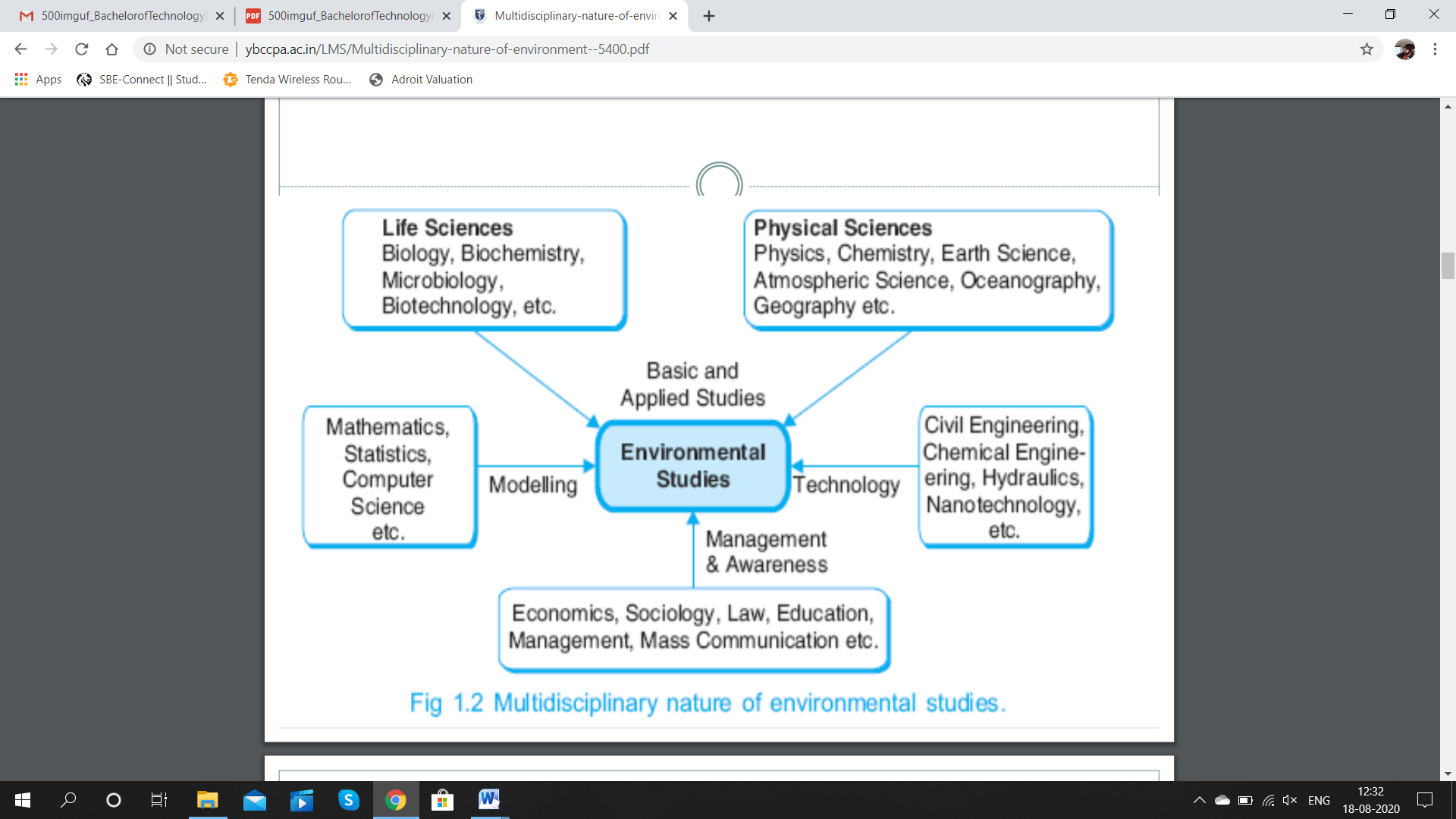
Depiction of Multidisciplinary Nature of Environmental Studies & its Components
- Environmental Studies as Applied Life Science: Life sciences including botany, zoology, microbiology, genetics, biochemistry, biotechnology, etc. help us in understanding the biotic components of environment and their interactions with each other and with abiotic components.
- Environmental Studies as Basic Physical Sciences: Core branches of physical sciences such as Chemistry, Physics, Geography, etc. give us an overview of chemical & physical structure of biotic components. Flow of energy transfer from one form to another also comes under this domain.
- Environmental Studies as Modeling Tool: It includes Mathematical Interpretations, Statistical Data Analysis, Computer Aided Analysis of Environment & its components.
- Environmental Studies as Technology: Branches of Civil Engineering, Chemical Engineering, Environmental Engineering, etc. have to deal with sustainable technological development without harming the environment in the form of Pollution Control, Waste Treatment and Reduction in overexploitation of natural resources.
- Environmental Studies as Management & Awareness: It covers all the rules regulations, laws and acts made in order to protect the environment and to create equilibrium between all life forms to sustain life and growth on earth.
Scope and importance
Like its multidisciplinary nature, scope of Environmental Studies is also wide as follows:
1. The study makes mindfulness among the individuals to think about different sustainable and non-renewable assets of the surroundings.
2. It gives the information about natural frameworks and circumstances related to human survival.
3. It gives fundamental idea about biodiversity and risks related to it.
4. The examination empowers one to create a cause & effect relationship of consequences caused by human activities of our natural surroundings.
5. It empowers one to choose most suitable alternative from available pool in order to reduce overuse of natural resources.
6. The awareness of Environmental Studies empowers ecologically educated residents by letting them know about the natural demonstrations, rights, rules, regulations, enactments, amendments in the existing environmental acts and so on to settle on proper decisions and choices for the insurance and improvement of the earth and its inhabitants.
7. The study reveals the social issues like over population, health, cleanliness and sanitation. It gives remedial measures to these issues in the most suitable manner.
8. The investigation attempts to recognize and create the eco-friendly skills and non-conventional technologies that would not create any hindrance in the pathway of development without putting an extra burden on environment.
9. It shows us the requirement for supportable usage of resources as these assets are acquired from our predecessors. Hence it is our responsibility to pass these on to our forthcoming generations without decaying their overall quality.
10. The scope of Environmental Studies is incomplete without its impact on employment opportunities in the form of Environmental-Journalism, Research & Development, Environmental Management, etc.
Importance :
1) Environmental studies help us to maintain ecological balance and equilibrium in the environment by providing a basic platform for interaction of environmental system and inter-related processes.
2) It gives information regarding the changes that takes place due to various factors and helps in gathering skills to analyses various environmental processes and the effect of human activities on them.
3) Environmental studies help to achieve sustainable development in order to achieve a state of optimum utilization of resources without affecting the needs of future generations. It ultimately makes us understand the relationship between development and the environment.
4) This field helps to educate people regarding their responsibilities and lawful duties towards the protection of environment.
5) Environmental study helps us to analyses the impact of human activities on various processes occurring in water, air and land which leads to contamination and results in environmental pollution
6) It also deals with the most important issues like safe and clean potable water, health-hygiene and cleanliness of surroundings
7) The discipline provides knowledge of the environment and various environmental issues. It examines the scientific base for environmental, cultural and social concerns about our present energy needs, global climate changes, toxic emission and waste disposal.
8) Development and optimum utilization of energy resources is an important aspect of environmental studies.
9) Environmental acts, rules, regulations, law, amendments and fields like business administration, environmental engineering is emerging as new career opportunities under its domain.
10) To analyze the complex nature of vast bio-diversity on our planet, we need scientific approach of Environmental - Studies.
The United Nations Conference on Environment and Development (UNCED), also known as the Rio de Janeiro Earth Summit , Rio Summit, Rio Conference, and Earth Summit (Portuguese: ECO92), was a major United Nations conference held in Rio de Janeiro from 3 to 14 June 1992. In 2012, the United Nations Conference on Sustainable Development was also held in Rio, and is also commonly called Rio+20 or Rio Earth Summit 2012. It was held from 13 to 22 June. Working towards international agreements which respect the interests of all and protect the integrity of the global environmental and developmental system, recognizing the integral and interdependent nature of the Earth, our home.
Climate Change
Climate is the average weather at a given point and time of year, over a long period (typically 30 years) . Climate is the average weather at a given point and time of year, over a long period (typically 30 years). A warming planet alters weather patterns, water supplies, seasonal growth for plants and a sustainable way of life for us and the world’s wildlife. Climate change has already started, but it’s not too late to take action.
Changes occur due to climate change are:
- Sun’s output
- Earth’s orbit
- Drifting continents
- Volcanic eruptions
Global warming
Global warming is a Global phenomenon. It refers to a gradual increase in the temperature of the Earth due to trapping of green house gases. A gradual increase in the overall temperature of the earth's atmosphere generally attributed to the greenhouse effect caused by increased levels carbon dioxide, CFCs, and other pollutants. Warming of the climate system is unequivocal, and scientists are 95-100% certain that it is primarily caused by increasing concentrations of greenhouse gases produced by human activities such as the burning of fossil fuels and deforestation. Gases such as CO2, SO2, NO2,CH4, etc. Are the green house gases. Most of these are the polluting gases that are produced by the industries. These gases trap the heat from the sunrays that are reflected from the sun.
Causes of Global Warming
It is the effect of the process of trapping of Heat due to CO2 which has been going on since times unknown. As we burn fossil fuels like coal, oil and natural gas for energy or cut down and burn forests to create pastures and plantations, carbon accumulates and overloads our atmosphere. Certain waste management and agricultural practices aggravate the problem by releasing other potent global warming gases, such as methane and nitrous oxide.
The major greenhouse gases are water vapor, which causes about 36–70% of the greenhouse effect; carbon dioxide (CO2), which causes 9–26%; methane (CH4), which causes 4–9%;and ozone (O3), which causes 3-7%. Clouds also affect the radiation balance.
Human activity since the Industrial Revolution has increased the amount of greenhouse gases in the atmosphere, leading to increased radioactive forcing from CO2, methane, troposphere ozone, CFCs and nitrous oxide.
Effects of global warming
- Sea level rise is accelerating. The planet's temperature is rising.
- Dangerous heat waves are becoming more common.The number of large wildfires is growing.
- Extreme storm events are increasing in many areas. More severe droughts are occurring in others. These are having significant and harmful effects on our health, our environment, and our communities.
Prevention of Global Warming
The various ways to control Global Warming are:-
- Control of population. But, since it is not possible to control population, the best way to control Global warming is by planting trees - Decrease deforestation/plant forests
- Produce more fuel-efficient vehicles
- Use of ecofriendly and biodegradable products.
- Improve energy-efficiency in buildings
- Develop carbon capture and storage processes
Acid rain
ACID RAIN is a rain or any other form of precipitation that is usually acidic i.e. it has low ph. Acid rain is caused by emissions of sulphur dioxide and nitrogen oxide, which react with water molecules in the atmosphere to produce acids.
Involves deposition of aqueous acids, acidic gases and acidic salts. Acid deposition has 2 parts: wet and dry - Wet deposition refers to acidic rain, fog & snow - Dry deposition refers to acidic gases and particles - Half of the acidity in the atmosphere falls back to earth through dry deposition.
Sources
Acid rain comes from chemical reactions in the atmosphere among oxygen, water and sulfur or nitrogen oxides. When sulfur dioxide dissolves in small droplets of water in clouds, it reacts with the hydrogen and oxygen of the water to form a weak solution of sulfuric acid. Similarly, nitrogen oxides form weak nitric acid in water droplets. The clouds can drift over hundreds of miles carrying their acid droplets. When conditions are right for rain, the droplets grow and fall to the ground. In many areas of the United States, such as the great plains, the acid rain falls mostly on land used for agriculture.
Causes of Acid Rain
The primary cause of acid rain is the emission of harmful gases and emissions by industrial power plants and factories, and to some extent, cars as well.
Burning of fossil fuels lead to emission of gases that give oxides of Sulphur and nitrogen.
Burning of gasoline and diesel in cars build the amount of acidified water droplets in the atmosphere.
Effects of Acid Rain
The effects of acid rain are unhealthy and harmful. Buildings, national monuments and bridges tend to deteriorate faster.
Acid rain has been found to be very hard on trees. It weakens them by washing away the protective film on leaves, and it stunts growth.
The biggest reason to find satisfactory solutions for acid rains is the damage to natural ecosystems. This rain will affect the plants, trees, rivers, lakes, soil and land wherever it may fall on.
Animals and plants that live in such areas are severely affected. Their food sources get diminished, they may develop unhealthy diseases or mutations, or they may even die in extreme cases,
EFFECT ON HUMANS
The pollutants that cause acid rain—Sulphur dioxide and nitrogen oxides damage human health. These gases interact in the atmosphere to form fine sulphate and nitrate particles that can be transported long distances by winds and inhaled deep into people's lungs. When we breathe in air pollution, these very fine particulates can easily enter our body, where they can cause breathing problems (asthma), bronchitis and over time even cause skin cancer.
Solutions for acid rain
To solve the acid rain problem, people need to understand how acid rain damages the environment. They also need to understand what changes could be made to the air pollution sources that cause the problem. Use Low Sulphur Coal The amount of Sulphur oxides emitted by a power plant can be reduced by burning coal with a very low percentage of Sulphur present.
Ozone layer depletion
The ozone layer in the upper atmosphere absorbs the sun’s ultraviolet radiation, preventing it from reaching the earth’s surface. This layer in the atmosphere protects life on earth from the dangerous UV radiation from the sun. The chemicals called chlorofluorocarbons or CFCs, which were used as refrigerants and aerosol spray propellants, posed a threat to the ozone layer.
The destruction of the ozone layer is seen to cause increased cases of skin cancer and cataracts. It also causes damage to certain crops and to plankton, thus affecting natures food chains and food webs. This in turn causes an increase in carbon dioxide due to the decrease in vegetation. Protecting the Ozone Layer Ban the use of CFC’s Have to replace with something Current replacements are greenhouse gases and do not eliminate ozone depletion, just slow it down.
Population growth
There is strong evidence that the growth of the world population poses serious threats to human health, socioeconomic development and the environment. It has taken only 12 years for the world population to grow from 5 billion to today's 6 billion. This is the shortest time ever to add 1 billion people — a number equivalent to the population of India or the combined population of the United States and Europe.
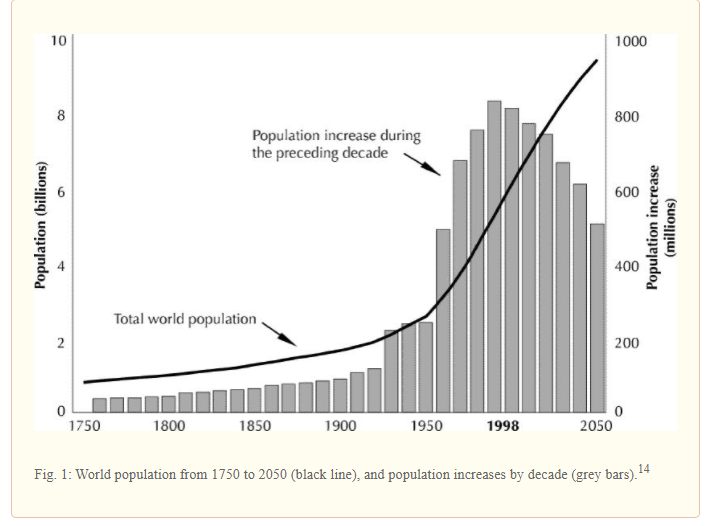
Some 10 000 years ago, when only about 5 million people inhabited the Earth, few biological systems were seriously damaged by human activity. Today, however, the world faces an environmental dilemma. Current demands are depleting many of the Earth's natural resources and ecological services. Within the next 50 years, it is likely that those life-supporting systems will somehow have to accommodate 3 billion more people as well as support desperately needed advances in living standards for those in poverty, particularly the 3 billion people now living on about $2 a day.
The impact of humans on their environment is related to population size, per capita consumption and the environmental damage caused by the technology used to produce what is consumed. The exploitation of technology and the high consumption pattern of people in Japan, Europe, the United States and Canada have a greater adverse impact per capita on the world's environment than that of a subsistence farmer in Bangladesh, for example. Although they represent 20% of the world's population, the 1.2 billion people living in developed countries consume an estimated 67% of all resources and generate 75% of all waste and pollution.
There are many important interactions between population growth, consumption, environmental degradation and health. Human activity has already transformed an estimated 10% of the Earth's surface from forest or rangeland into desert. The productive capacity of 25% of all agricultural lands, an area equal to the size of India and China combined, has already been degraded. Unproductive land and food scarcity currently contribute to malnutrition among 1 billion people, with infants and children suffering the most serious health consequences.
Environmental degradation, declining food security and uncontrolled epidemics of communicable diseases have slowed, and even reversed, the demographic transition to low death rates in some poor countries. In contrast to developed countries, where cardiovascular diseases and cancer are the leading causes of death, in poor countries infectious diseases cause 45% of all deaths.
Population explosion
The rapid growth of population is perhaps the most obvious factor affecting the present and future national and regional development, but it is by no means the only population problem in the world today. The main problem is that of ‘Population Explosion’.
Population explosion doesn’t mean overpopulation or population density. In fact, overpopulation or population density is not the major problem. The problem arises when the economic developments fails to maintain pace with population growth. So, the most important factors regarding population are how fast population is growing; and most important is where it is growing. For example, Japan has a high population density but it ranked first on the human development index formulated by U.N.D.P. On the other hand, low population density areas of Africa or S. America are unable to support the existing population. Thus, the size, distribution and structure of the population within a country must be viewed in relation to its natural resources and the techniques of production used by its population. The extent to which they are used and the way in which they are utilized determine whether an area/country is under-or over-populated and hence witnessing population explosion or not. A country is said to have an “optimum population” so long as the number of people is in balance with the available resources of the country. If in a country the process of industrialization accompanied by urbanization is not fast and education is not widespread, then this is really a grave situation called as Population Explosion.
Role of Information Technology in Human Health
Its various applications include:
- Bioinformatics and osteoporosis
The application of bioinformatics is in the emerging possibility for the cure of osteoporosis-a crippling disease caused by the breakdown of bone, caused by a class of molecules called Cathepsin K. Now the pharmaceutical companies have to find a drug that blocks the Cathepsin K gene only.
- Role in genome sequencing
Bioinformatics played a key role in the final stages of the Human Genome Project. In just four weeks, James kent a Ph.D student of California University produced a computer programmer that helped the public consortium to complete the sequencing in time and to present the draft sequence along with Celera Genomics on June26, 2000.
- DNA databases or data banks having genetic information about populations together with their personal physical characteristics (eye color, height, weight, etc.), finger prints, dental records, medical records, financial records, etc. are used by the Government Departments to identify missing persons, by the investigating agencies (e.g., FBI, CBI, RAW, etc.) to identify criminals, and also by the insurance companies to prevent insurance fraud.
- Many organizations, such as WHO, maintain their web sites with information about endemic, epidemic and communicable diseases to inform people about dangers involving populations.
- Information about new drug release, their mode of action, indications and risk are also available on web sites.
- Any new development in the field of surgery is also available on net to be referred by the doctors of any country at any time.
- Telemedicine and distance medicine are now far-reaching along with documentation and display of human anatomy with the help of internet.
B) Ecosystems:
Concept of an ecosystem
Term ‘Ecosystem’ was tossed in the year 1935 by an English Botanist- A.G. Tansley.
An ecosystem is a geographic area which contains both Biotic as well as Abiotic factors and their interaction with each other.
There are various types of Ecosystems such as:
- Terrestrial
- Aquatic
- Desert
- Grassland
- Forests
- Marine
- Freshwater, etc.
Structure and function of an ecosystem
Ecosystem has 2 major components:
1) Biotic (Living)
2) Abiotic (Non- Living)
These 02 components when interacts with each other in a system, then give rise to an ecosystem.
Biotic Components are of 3 further types:
1) Producers
2) Consumers
3) Decomposers
Abiotic Components are of 3 sorts:
1) Climatic Factors (Rain, Lightning, Humidity, Wind, Temperature, etc.)
2) Edaphic Factors (Soil based factors such as pH, minerals, etc.)

Classification of Ecosystem and its components
Functions:
Basic function of ecosystem is merely an exchange of energy and nutrients in the food chain which impacts the survival of existence of all life forms. This exchange is responsible for the setting up of equilibrium between biotic and abiotic components.
1) Producers: They prepare their own food and initiate the cycle.
Example: Plants prepare their own food with the help of photosynthesis.
2) Consumers: These are primary (who feeds on producers) & secondary (who feed on both producers and primary consumers)
Example: Herbivores & Carnivores
3) Decomposers: Feeds on dead of lifeless residues of producers and consumers.
Example: Bacteria, Fungi, etc.
The behavior of energy in ecosystem can be conveniently termed as energy flow because of unidirectional energy transformations. Total energy flow that constitutes the energy environment has already been dealt in detail, and now we take up the study of that portion of the total energy flow that passes through the biotic components of the ecosystem. Entrance of energy, its retention within the ecosystem and dissipation into space, are governed by two laws of thermodynamics. According to the first law, the law of conservation of energy, in a closed system, no energy comes in or escapes out and not created or destroyed but may be altered from one form to another. The second law of thermodynamics, the law of entropy, states that there is always a tendency for increase in entropy or degradation from a concentrated (non-random) to a dispersed (random) form leading to dissipation of heat. All the energy entering the earth’s surface can be accounted for. Some energy is used in photosynthesis; the rest is used in converting the water into vapors or heating the soil and air. Ultimately the energy reflected back to outer space as heat. The light energy fixed by green plants in the process of photosynthesis may be represented by the following equation:
Out of the amount of energy so fixed by green plants, some is released again in respiration. The fixed energy, in the form of food, then passes from plant source through herbivores to carnivores. At each stage of food transfer, potential energy is released, resulting in further loss of a large part of energy. The energy flow, thus follows the second law of thermodynamics.
Ecological succession is the phenomenon or process by which an ecological community undergoes more or less orderly and predictable changes following disturbance or initial colonization of new habitat. Succession was among the first theories advanced in ecology and the study of succession remains at the core of ecological science. Succession may be initiated either by formation of new, unoccupied habitat (e.g., a lava flow or a severe landslide) or by some form of disturbance (e.g. Fire, severe wind throw, logging) of an existing community.
- Primary succession
Succession that begins in new habitats, uninfluenced by pre-existing communities is called primary succession. In primary succession pioneer species like lichen, algae and fungus as well as other abiotic factors like wind and water start to "normalize" the habitat. This creating conditions nearer optimum for vascular plant growth; pedogenesis or the formation of soil is the most important process.
These pioneer plants are then dominated and often replaced by plants better adapted to fewer odd conditions, these plants include vascular plants like grasses and some shrubs that are able to live in thin soils that are often mineral based.
For example, spores of lichen or fungus, being the pioneer species, are spread onto a land of rocks. Then, the rocks are broken down into smaller pieces and organic matter gradually accumulates, favoring the growth of larger plants like grasses, ferns and herbs. These plants further improve the habitat and help the adaptation of larger vascular plants like shrubs, or even medium- or large-sized trees. More animals are then attracted to the place and finally a climax community is reached.
2. Secondary succession
Succession that follows disruption of a pre-existing community is called secondary succession. (e.g. Forest fire, harvesting, hurricane) that reduces an already established ecosystem (e.g. a forest or a wheat field) to a smaller population of species, and as such secondary succession occurs on preexisting soil whereas primary succession usually occurs in a place lacking soil.
1) Food Chains:
Food chains were first introduced by the African-Arabic scientist and philosopher Al-Jahiz in the 9th century but got popularized by Charles Elton in the year 1927.
It is defined as an order of living organisms in a community in which continuous consumption of one organism by another organism and so on takes place.
It can be stated as a chain of organisms in their natural surroundings, through which energy is transferred.
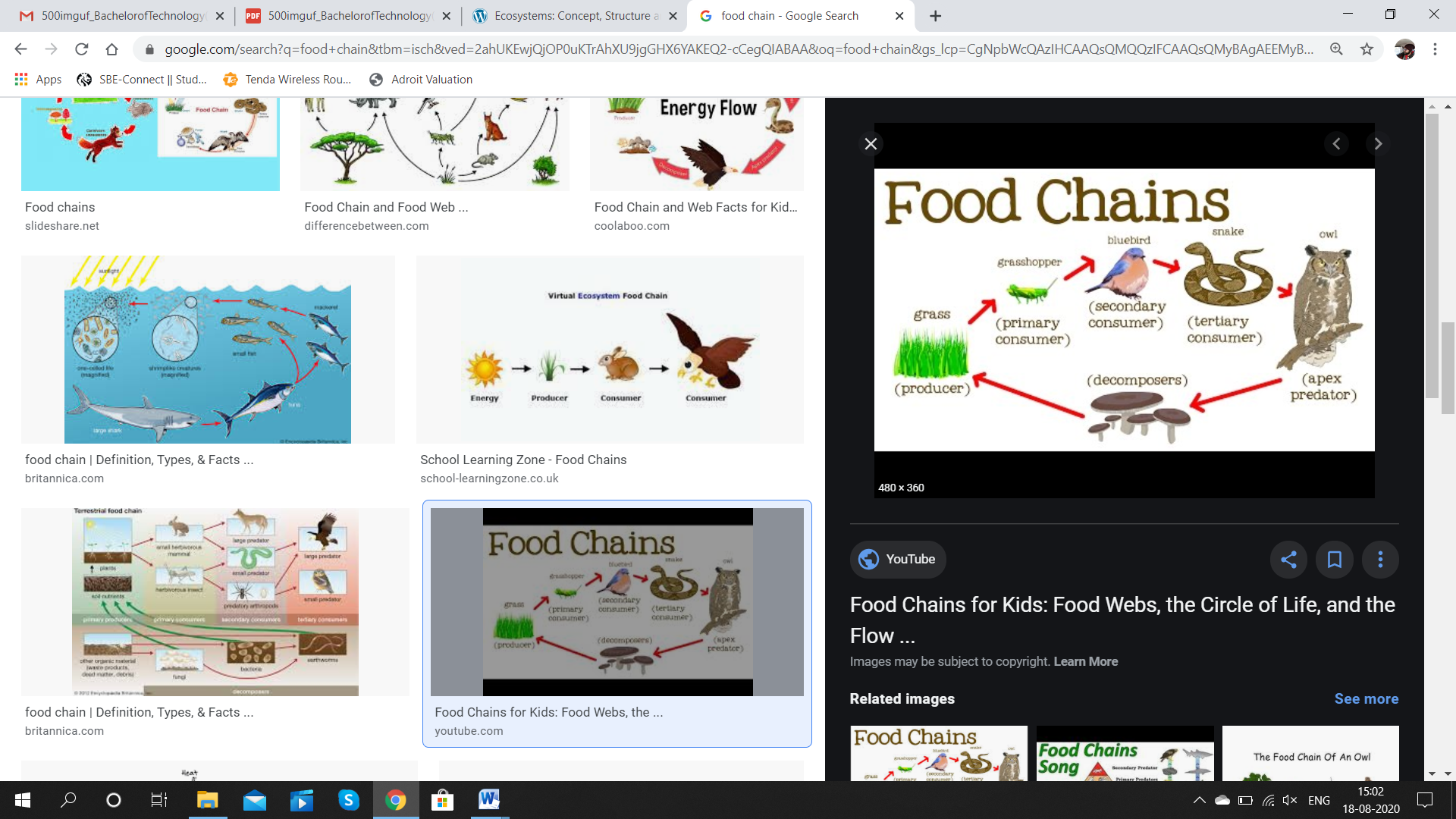
A typical Food Chain comprises of producers, consumers and decomposers.
2) Food Web:
A food web may be defined as a graphical representation depicting interconnection between various food chains.
.
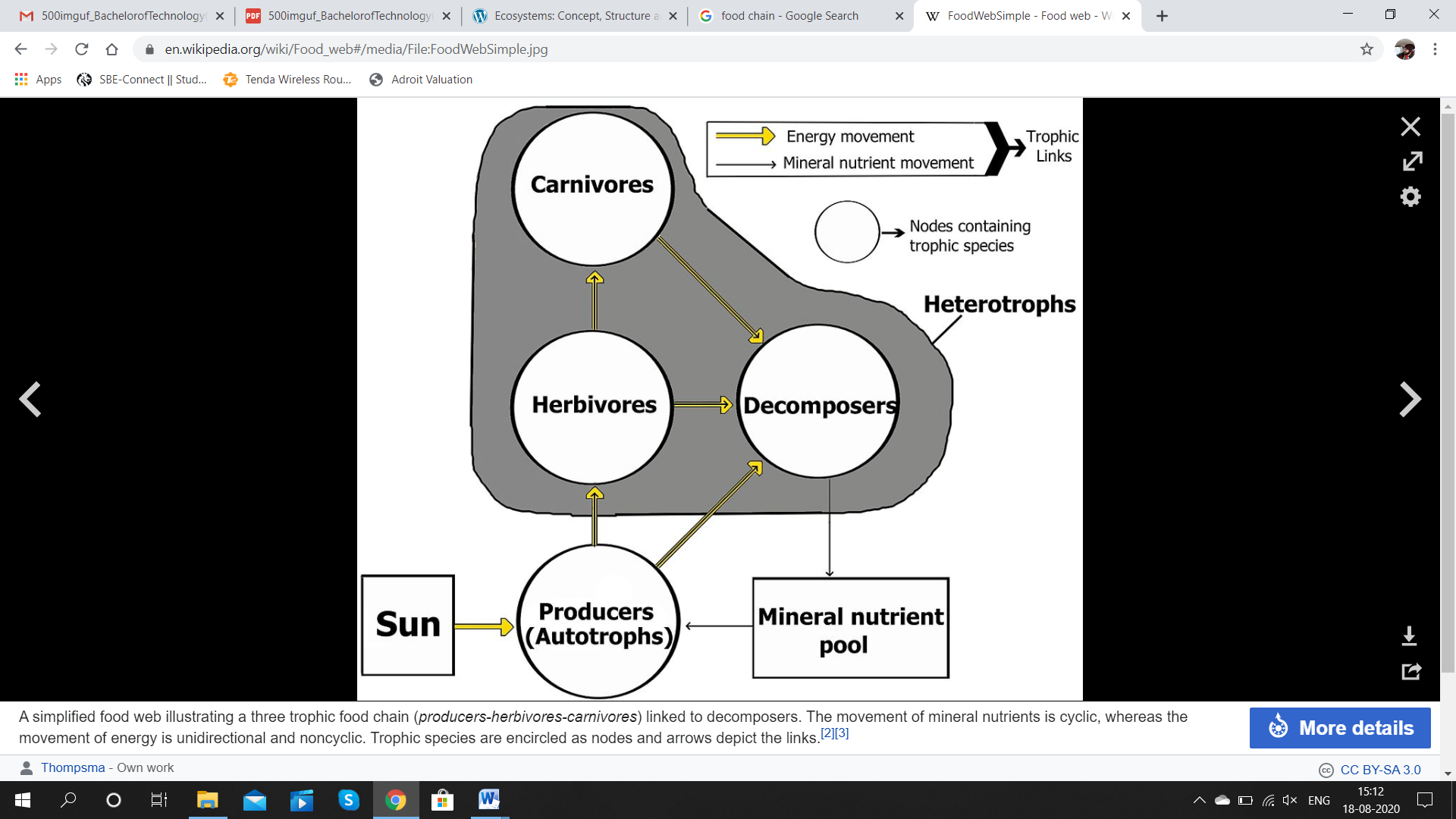
Simplified Food Web depicting energy movemet and nutrient flow between 3 basic food chain components (Carnivores, Herbivores & Decomposers)
As a food web contains a number of interconnected food chains, hence it results in a complex structure.
Whenever various food chains form such a structure by overlapping each other, it results in generation of a Food Web.
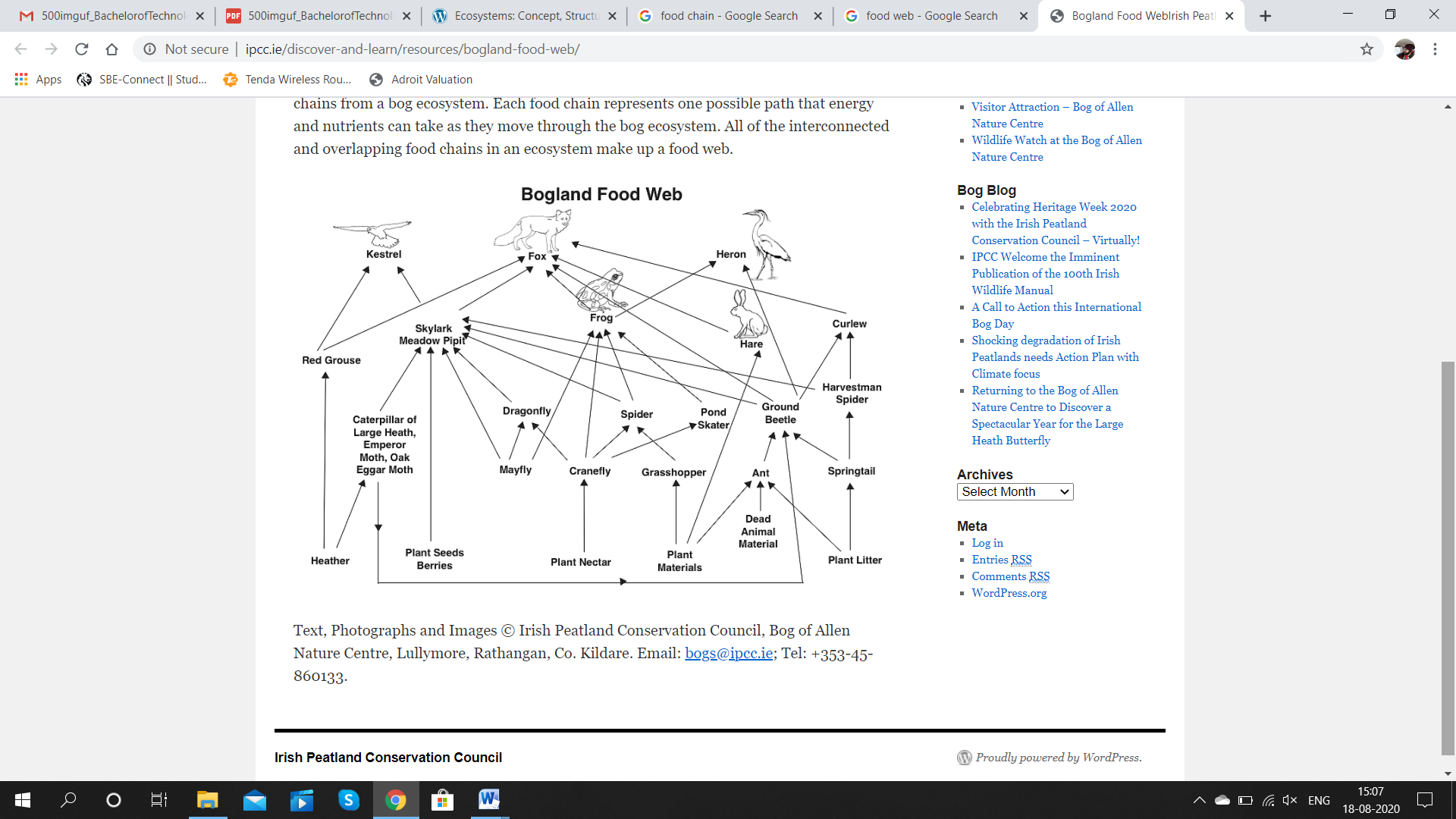
A complex food webs
Forest ecosystem
A terrestrial environment consisted and dominated by trees growing in a closed system is called as a forest.
So, a scientific study of interrelated processes, patterns of flora, fauna and their surroundings in a forest is stated as Forest Ecosystem.
- Case: Chunati Wildlife Sanctuary (CWS), Bangladesh
Forest Resource Collection is the significant employment choice for larger part of the individuals living in or around the Chunati Wildlife Sanctuary (CWS), Bangladesh.
The study helped to identify the nature and sorts of forest resources, their collection and quantification in order evaluate the value of the amount of forest resources collected by different resource collectors. Market based approach was being used to estimate the value of the collected resources. Interviews of the resource collectors and multiple checking of the selling price of that particular resource from the adjacent local markets was criteria used for it
A total of 28 forest trails (used by the local communities as entry or exit points for forest resource collection) out of 56 were selected proportionately from two forest ranges (12 from Chunati and 16 from Jaldi) and from all categories of forest trails based on frequency of use (heavily used, moderately used and less used) for the study.
The survey was conducted during the dry season (October to May) as it is found to be suitable for resource collection compared to wet season (June to September).
Result of the study shows that 481 resource collectors per day enter into the CWS through surveyed trails before noon and get back before evening of which 22% are female. Higher numbers of resource collectors were found to carry fuel wood (30%) followed by NTFP or fruits (13%), timber (11%), agricultural products (11%), bamboos or bamboo shoots (10%), sun grass (10%), etc.
The mode of carrying forest resources was by shoulder load (63%) followed by head load (30%). Among the resource collectors 84% are adult and the rest 16% are minor. The resource collectors spend 5.71 hours per day on average at the forests to collect resources and travel 6.41 km on average for each visit to the CWS.
The average value of the resources collected by each collector on each visit is BDT 301 (USD 3.71) which may be calculated as BDT 289,735 (USD 3,697.16) for the whole of CWS per day.
The findings of this study will give a better insight to the problem of forest degradation in Bangladesh and particularly in the CWS.
b) Grassland ecosystem
A grassland ecosystem is one which is dominated by non woody (herbaceous) plants and various types of grass.
- Case: Grassland of Middle South Inner Mongolia
In this study, we analyses the changes of indicators of ecosystem services and functions, in order to understand the main cause of grassland degradation due to climatic variation or land use changes in the middle-south Inner Mongolia.
The soil nutrient and the water supply of supporting service got recovery during 1988–2008. The loss of net primary production declined, and the quality of the retained unconverted grassland (RUG) even increasingly degraded from 2000 to 2008.
Analytical results show that environmental degradation on the land-use-changed-area is lower than that on the RUG from 2000 to 2008. It illustrates that climatic variation has more negative impacts on grassland ecosystem service, and which is significantly higher than the so-called “overgrazing” induced grassland degradation.
Moreover, it cannot be excluded that those species died out on the RUG due to natural selection or competitive evolution in an evolutionary process under the deteriorative weather condition rather than overgrazing.
The positive impacts of human activities such as conservation programs and wildlife protection laws also benefit to regional grassland ecosystem obviously in the study area, so that can delay the environmental degradation even if each planet has its life cycle.
It indicates that an integrated regional planning involving the considerations of climatic conditions, geographical characteristics, socioeconomic factors, and ecological functions and biodiversity can benefit to regional grassland conservation based on monitoring and management via scientific methods
c) Desert ecosystem
A desert is a barren land of landscaping area with very little precipitation (rain), lack of vegetation and very hostile living conditions for plant and animal life.
Case: The Western Desert, USA
The western desert covers an area of over 2 lacs sqkms in south-west USA.
It has 03 sub-deserts: Mojave, Chihuhuan and Sonoran.
It extends in the states of Arizona & California (USA) and some parts of New Mexico too.
Major Extractions done in this region are: Coal, Copper, Uranium, etc.
Due to its solar potentiality, it has a huge capacity to generate solar electricity.
Some oil reserves are also found here.
Peppers and grapes are few farming crops found in this region.
With around 30 million tourists per year, tourism is a key indicator of its economy.
Some challenges that are being faced in Wester Desert are as follows:
Extreme Temperature
Inaccessibility due to its vastness
Inadequate water supply
Very low rainfall
Hoover Dam, constructed on Colorado River is playing a crucial resource for counteracting irrigation and drinking problems.
d) Aquatic ecosystem (ponds, streams, lakes, rivers, oceans, estuaries)
‘Aqua’ means ‘water’. Hence, an ecosystem present in a body of water is called an Aquatic Ecosystem.
Types of Aquatic Ecosystems:
1) Freshwater Ecosystem
2) Marine Ecosystem
3) Transitional Communities
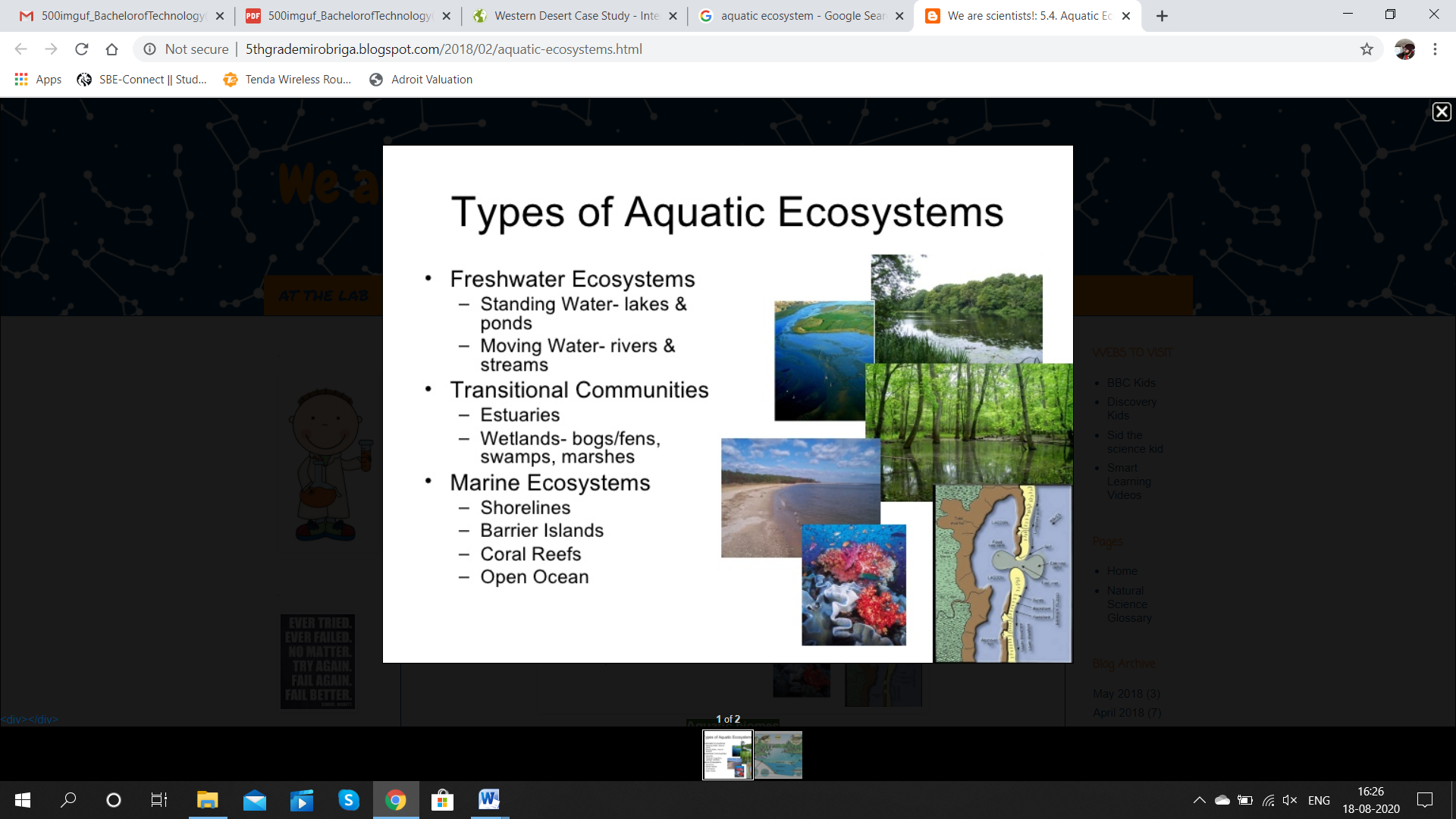
Classification of Aquatic Ecosystem
References :
- Textbook Of Environmental Science By Deeksha Dave And E.Sai Baba Reddy, Cengage
- Publications.
- Text Book Of Environmental Sciences And Technology By M.Anji Reddy, Bs Publication.
- Comprehensive Environmental Studies By J.P.Sharma, Laxmi Publications.
- Environmental Sciences And Engineering – J. Glynn Henry And Gary W. Heinke – Prentice Hall Of
- India Private Limited.
- A Text Book Of Environmental Studies By G.R.Chatwal, Himalaya Publishing House